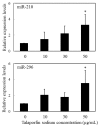Regulation of miRNA expression by low-level laser therapy (LLLT) and photodynamic therapy (PDT)
- PMID: 23807510
- PMCID: PMC3742202
- DOI: 10.3390/ijms140713542
Regulation of miRNA expression by low-level laser therapy (LLLT) and photodynamic therapy (PDT)
Abstract
Applications of laser therapy, including low-level laser therapy (LLLT), phototherapy and photodynamic therapy (PDT), have been proven to be beneficial and relatively less invasive therapeutic modalities for numerous diseases and disease conditions. Using specific types of laser irradiation, specific cellular activities can be induced. Because multiple cellular signaling cascades are simultaneously activated in cells exposed to lasers, understanding the molecular responses within cells will aid in the development of laser therapies. In order to understand in detail the molecular mechanisms of LLLT and PDT-related responses, it will be useful to characterize the specific expression of miRNAs and proteins. Such analyses will provide an important source for new applications of laser therapy, as well as for the development of individualized treatments. Although several miRNAs should be up- or down-regulated upon stimulation by LLLT, phototherapy and PDT, very few published studies address the effect of laser therapy on miRNA expression. In this review, we focus on LLLT, phototherapy and PDT as representative laser therapies and discuss the effects of these therapies on miRNA expression.
Figures


Similar articles
-
Efficacy of photodynamic therapy or low level laser therapy against steroid therapy in the treatment of erosive-atrophic oral lichen planus.Photodiagnosis Photodyn Ther. 2018 Mar;21:404-408. doi: 10.1016/j.pdpdt.2018.02.001. Epub 2018 Feb 4. Photodiagnosis Photodyn Ther. 2018. PMID: 29414735 Clinical Trial.
-
Low-level laser therapy regulates microglial function through Src-mediated signaling pathways: implications for neurodegenerative diseases.J Neuroinflammation. 2012 Sep 18;9:219. doi: 10.1186/1742-2094-9-219. J Neuroinflammation. 2012. PMID: 22989325 Free PMC article.
-
Low-level light therapy potentiates NPe6-mediated photodynamic therapy in a human osteosarcoma cell line via increased ATP.Photodiagnosis Photodyn Ther. 2015 Mar;12(1):123-30. doi: 10.1016/j.pdpdt.2014.10.009. Epub 2014 Nov 13. Photodiagnosis Photodyn Ther. 2015. PMID: 25462575 Free PMC article.
-
Laser and light therapies for the treatment of necrobiosis lipoidica.Lasers Med Sci. 2021 Apr;36(3):497-506. doi: 10.1007/s10103-020-03147-3. Epub 2020 Sep 24. Lasers Med Sci. 2021. PMID: 32970197 Review.
-
Review on the molecular mechanisms of low-level laser therapy: gene expression and signaling pathways.Lasers Med Sci. 2025 Mar 25;40(1):160. doi: 10.1007/s10103-025-04393-z. Lasers Med Sci. 2025. PMID: 40131476 Review.
Cited by
-
Impact of low-level laser therapy on the dynamics of pressure ulcer-induced changes considering an infectious agent and cathelicidin LL-37 concentration: a preliminary study.Postepy Dermatol Alergol. 2018 Dec;35(6):582-586. doi: 10.5114/ada.2018.77609. Epub 2018 Nov 8. Postepy Dermatol Alergol. 2018. PMID: 30618525 Free PMC article.
-
Effect of diode low level laser and red light emitting diode irradiation on cell proliferation and osteogenic/odontogenic differentiation of stem cells from the apical papilla.BMC Oral Health. 2022 Nov 25;22(1):543. doi: 10.1186/s12903-022-02574-8. BMC Oral Health. 2022. PMID: 36434589 Free PMC article.
-
Direct 1O2 optical excitation: A tool for redox biology.Redox Biol. 2017 Oct;13:39-59. doi: 10.1016/j.redox.2017.05.011. Epub 2017 May 25. Redox Biol. 2017. PMID: 28570948 Free PMC article. Review.
-
Therapeutic comparison between treatments for Vulvar Lichen Sclerosus: study protocol of a randomized prospective and controlled trial.BMC Womens Health. 2017 Aug 10;17(1):61. doi: 10.1186/s12905-017-0414-y. BMC Womens Health. 2017. PMID: 28793884 Free PMC article. Clinical Trial.
-
The Effect of Low-Level Laser Therapy on the Viability of Human Dental Pulp Stem Cells.J Lasers Med Sci. 2022 Dec 8;13:e60. doi: 10.34172/jlms.2022.60. eCollection 2022. J Lasers Med Sci. 2022. PMID: 37041791 Free PMC article.
References
-
- Maiman T.H. Stimulated optical radiation in ruby. Nature. 1960;187:493–494.
-
- Khatri K.A., Mahoney D.L., McCartney M.J. Laser scar revision: A review. J. Cosmet. Laser Ther. 2011;13:54–62. - PubMed
-
- Chung S.H., Mazur E. Surgical applications of femtosecond lasers. J. Biophotonics. 2009;2:557–572. - PubMed
-
- Zhao Z., Wu F. Minimally-invasive thermal ablation of early-stage breast cancer: A systemic review. Eur. J. Surg. Oncol. 2010;36:1149–1155. - PubMed
-
- Siribumrungwong B., Noorit P., Wilasrusmee C., Attia J., Thakkinstian A. A systematic review and meta-analysis of randomised controlled trials comparing endovenous ablation and surgical intervention in patients with varicose vein. Eur. J. Vasc. Endovasc. Surg. 2012;44:214–223. - PubMed
Publication types
MeSH terms
Substances
LinkOut - more resources
Full Text Sources
Other Literature Sources

